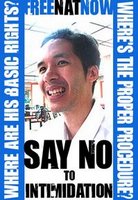Sapura’s 10-digit spy bonanza December 29, 2006
Posted by elizabethwong in Economy, Human Rights, Malaysia, Op-Eds, Writings.trackback
(Updated)
Sixteen hours after the story broke in Bernama, Sapura’s COO, Rodzlan Akib Abu Bakar came out to deny it is neither in the running to receive the RM 1 billion contract nor is it involved with EADS. (View Here)
——————————–
Santa must have had trouble getting to this part of the world, since it was only today he came a-calling at Sapura with a surveillance contract worth RM 1 billion.
Bernama’s Tengku Noor Shamsiah Tengku Abdullah reported late this afternoon on the likelihood of Sapura securing a Federal government contract to supply 3,000 cameras in major cities in the Peninsular, in anticipation of Visit Malaysia Year 2007, as well as for ‘security’.
Earlier in March this year, Sapura-LTAT Communication Technologies Sdn Bhd won a RM 500 million contract to supply 3,000 Malaysian-made and designed tactical field radios to the armed forces.
EADS
Sapura is reported have partnered with the controversy-mired European defence-spy-aerospace giant – European Aeronautic Defence and Space Company (EADS) – which happens to be the parent company of the very troubled Airbus.
EADS has also been implicated in what is known as the French ‘Watergate’, which recently saw Prime Minister de Villepin as haute cuisiné for 17 hours prior to the holidays.
EADS is further accused of manufacturing key components of cluster bombs, extensively and covertly used in modern-day warfare, from Afghanistan to Lebanon, to the point that the Norwegian government’s pension fund dropped the company from its investment portfolio in June 2005.
In a February 2004 report, titled, “Undermining Global Security: the European Union’s arms exports”, Amnesty International reported that the EADS-Astrium satellite, HELIOS IIA – a high resolution infrared imaging spy satellite – launched on behalf of the Ministries of Defence of Belgium, France and Spain, was doing more than taking pictures of Big Foot, tulips and roses.
“[…] Military intelligence collected by this second satellite (HELIOS IIA) will also reportedly be provided to Colombia. Spain will also provide assistance and collaboration in the “fight against terrorism” with eavesdropping equipment and intelligence training developed in its fight against ETA.” (Chapter 10: Surveillance and “Intelligence” Technologies)
Tourism or Spyware?
Bearing in mind the recently-passed Criminal Procedure Code, which now allows the public prosecutor to give permission to the police to ‘intercept’ any form of communication on the mere basis of ‘suspicion’, this is an inevitable (and equally lucrative) step.
Whereas there have been intensive debates when the UK government sought to install CCTVs on its streets, on the justification that it will deter crime, there have been none here.
Preliminary studies on the correlation of CCTVs and crime have suggested that while there has been a drop in crimes in particular areas, it doesn’t necessarily mean criminals have decided to pick up knitting. Crimes have instead moved to other areas not covered by these CCTVs.
“The logic, and the statistics, are superficially impressive, but some analysts are not convinced. In a report to the Scottish Office on the impact of CCTV, Jason Ditton, Director of the Scottish Centre for Criminology, argued that many claims of crime reduction are little more than fantasy. “All (evaluations and statistics) we have seen so far are wholly unreliable”, The British Journal of Criminology went further by describing the statistics as “….post hoc shoestring efforts by the untrained and self interested practitioner “. (See also: Davies, S (1996) Big Brother : Britain’s web of surveillance and the new technological order, Pan Books, London)
Take for instance, the murder of the Mongolian interpreter, Altantuya Sharibuu. The likelihood of these ‘eyes’ capturing a scene from her explosive demise, said to have been committed in a remote part of the city, is low, compared to a gaggle of police watching her sip coffee at Starbucks.
Given that the emergency, medical and police resources here are sluggish at best and woefully under-staffed in the first place, what would one do with all the data streaming in from these 3,000 cameras 24/7?
The possibilities seem endless. After all CCTVs were used at the Penang Municipal Council to record images of a journalist’s legs during a meeting, instead of the proceedings.
Finally, Big Brother has descended upon us. Who he intends to watch, and why – now that’s a billion-ringgit question. (END) © WIP









who to watch those cctv stream? well, simple, now the unemployed graduates will be employed! Yeah! More civil servants… good unemployment stats… Boleh!